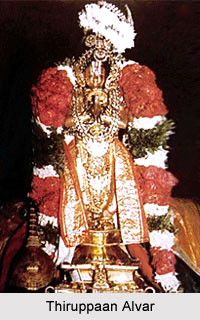 Thiruppaan Alvar, also known as Tiruppan Azhwar, was a much venerated poet saint from the ancient Tamil country, who existed during the 8th Century CE. Thiruppaan Alvar is one of the prominent twelve Alvar saints of South India, who are acknowledged for their association to Vaishnava tradition of Hinduism. The temples that were venerated by these Alvars were known as Divya Desam. Thiruppaan was considered as an untouchable and an outcast even though he was into a community. As birth was not a requisite qualification for devotion towards Lord Vishnu (Sriman Narayana), he is customarily regarded as one of the 12 great Alvars. Thirupaan Alvar has written an anthology titled Amalaanathi Piraan (AmalanAdhipiran) which comprises of 10 paasurams (hymns) on Srirangam Divya Desam. He was a follower of the Vaishnava Bhakti philosophy.
Thiruppaan Alvar, also known as Tiruppan Azhwar, was a much venerated poet saint from the ancient Tamil country, who existed during the 8th Century CE. Thiruppaan Alvar is one of the prominent twelve Alvar saints of South India, who are acknowledged for their association to Vaishnava tradition of Hinduism. The temples that were venerated by these Alvars were known as Divya Desam. Thiruppaan was considered as an untouchable and an outcast even though he was into a community. As birth was not a requisite qualification for devotion towards Lord Vishnu (Sriman Narayana), he is customarily regarded as one of the 12 great Alvars. Thirupaan Alvar has written an anthology titled Amalaanathi Piraan (AmalanAdhipiran) which comprises of 10 paasurams (hymns) on Srirangam Divya Desam. He was a follower of the Vaishnava Bhakti philosophy.
Early Life of Thiruppaan Alvar
Thiruppaan Alvar was born in the 8th century CE or 9th century CE, in Purthurmadhi year, in the Tamil month of Kaarthigai, in the Rohini Nakshatra on a Wednesday. He was born in the small village of Alagapuri near Srirangam (near Uraiyur), in Paanar Cheri. The community of Paanars is mainly a group of musicians and conventional composers who are competent of fascinating the listeners to the states of bliss and ecstasy. Due to their talents, the Paanars could influence the Devas (deities) and sages. The Paanar community was generally considered as outcastes.
Thiruppaan Alvar carried a veena in his hand and always sung praises of Lord Vishnu. He quickly attained popularity in the Tamil country for his musical skills. His talents as a Bhakti poet and musician and his skills to express and summon Bhakti (divinity) in the devotees influenced audiences from all over southern India. Later he was popularly known as Paanar Perumal. As Thiruppaan Alvar was an outcast, he was forbidden to come near the Kaveri River. Thus he stood close to the banks of the river near the Srirangam temple and recited praises of Lord Vishnu.
Thiruppaan Alvar as a Vaishnava Saint
According to legends, Loka Saaranga, a devoted Brahmin of the temple, one day came to Thiruppaan Alvar near the river and asked him to move away. But the poet saint was deeply engulfed in the singing the praises of the Lord that he could not hear the Brahmin`s request. Loka Saaranga threw a stone towards him to get his attention. But the stone hit Thiruppaan`s forehead and it started to bleed. Eventually the Alvar saint retired.
Later when Loka Saaranga returned to the Srirangam temple, he was surprised to see blood pouring out of the forehead of the idol of Lord Ranganatha, the presiding deity. Vishnu appeared in the dream of Loka Saaranga that night and instructed him to get Thiruppaan to the temple premises the next day. The Brahmin requested the poet to come to the temple, but Thiruppaan Alvar declined to set foot on the sacred Srirangam temple as he belonged to an outcast community and did not want to pollute the sacred place. Loka Saaranga informed him about the Lord`s instructions and Thiruppaan was pleased to great extent. Loka Saaranga offered him to get on his shoulders and he could carry the Alvar poet into the temple. Loka Saaranga carried Thiruppaan Alvar who was in a state of trance. Due to this incidence, the poet saint is also known as Munivaahanar, meaning the one astride a priest.
When Loka Saaranga and Thiruppaan Alvar reached the sanctum sanctorum, the alvar saint felt the bliss of Lord Vishnu and composed the work of Amalaanathi Piraan (Amalan Adhipiran), a poem narrating the splendour of Ranganatha, from head to foot of the Lord, in 10 paasurams or hymns. Thiruppaan Alvar laid his life at the feet of Vishnu. It is believed that the verses are more charming than even the sound of the Veena.
Literary Works of Thiruppaan Alvar
Amalaanathi Piraan contains 10 verses in the praise of Lord Vishnu sung by Thiruppaan Alvar. The initial verse composed by the Alvar poet is devoted to the Thiruvadi (lotus feet) of Arangan (Aranganathan). Then he saw the entire body (thirumeni) of Emperumaan and he recited a total of 10 hymns that describe the beauty and magnificence of Sri Ranganathar from his foot (thiruvadi) to his head (thirumudi).
In his 10 paasurams, Thiruppaan explains about the sparkling saffron cloth worn on the body of Ranganathar, his jewels, the stomach (thiru vayiru) from where Lord Brahma was created; the expansive chest of the Lord, the red lips and ultimately he described the attractiveness of the two wide eyes. After this the poet fell down and then he could not be found. It is widely believed that Thiruppaan Alvar united with the body of Thiruvaranganathan. Thiruppaan Alwar was engulfed by his love and devotion and thus he became a part of Lord Vishnu along with his mortal sheath.
Thiruppaan Alvar has also described the way and manner to live a proper human life in the 10 paasurams or hymns.













